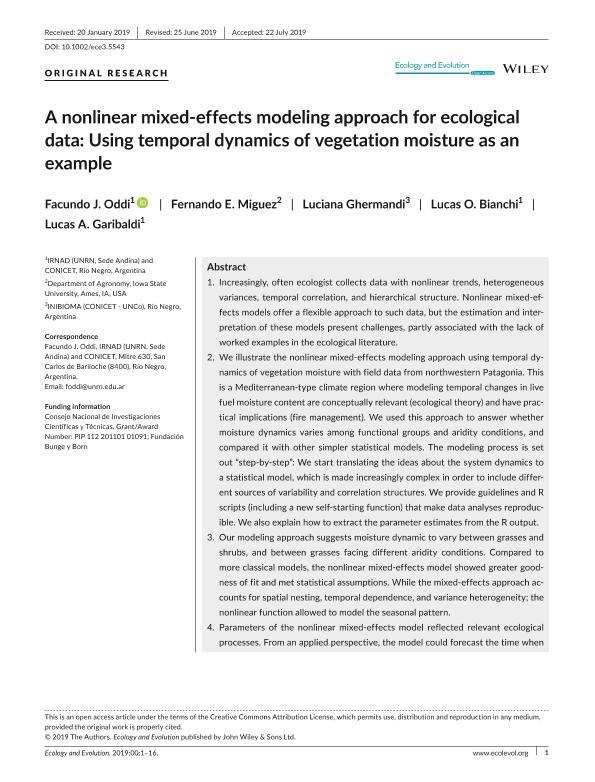Artículo
A nonlinear mixed-effects modeling approach for ecological data: Using temporal dynamics of vegetation moisture as an example
Oddi, Facundo José ; Miguez, Fernando E.; Ghermandi, Luciana
; Miguez, Fernando E.; Ghermandi, Luciana ; Bianchi, Lucas Osvaldo
; Bianchi, Lucas Osvaldo ; Garibaldi, Lucas Alejandro
; Garibaldi, Lucas Alejandro
 ; Miguez, Fernando E.; Ghermandi, Luciana
; Miguez, Fernando E.; Ghermandi, Luciana ; Bianchi, Lucas Osvaldo
; Bianchi, Lucas Osvaldo ; Garibaldi, Lucas Alejandro
; Garibaldi, Lucas Alejandro
Fecha de publicación:
15/08/2019
Editorial:
Wiley
Revista:
Ecology and Evolution
e-ISSN:
2045-7758
Idioma:
Inglés
Tipo de recurso:
Artículo publicado
Clasificación temática:
Resumen
Increasingly, often ecologist collects data with nonlinear trends, heterogeneous variances, temporal correlation, and hierarchical structure. Nonlinear mixed-effects models offer a flexible approach to such data, but the estimation and interpretation of these models present challenges, partly associated with the lack of worked examples in the ecological literature. We illustrate the nonlinear mixed-effects modeling approach using temporal dynamics of vegetation moisture with field data from northwestern Patagonia. This is a Mediterranean-type climate region where modeling temporal changes in live fuel moisture content are conceptually relevant (ecological theory) and have practical implications (fire management). We used this approach to answer whether moisture dynamics varies among functional groups and aridity conditions, and compared it with other simpler statistical models. The modeling process is set out “step-by-step”: We start translating the ideas about the system dynamics to a statistical model, which is made increasingly complex in order to include different sources of variability and correlation structures. We provide guidelines and R scripts (including a new self-starting function) that make data analyses reproducible. We also explain how to extract the parameter estimates from the R output. Our modeling approach suggests moisture dynamic to vary between grasses and shrubs, and between grasses facing different aridity conditions. Compared to more classical models, the nonlinear mixed-effects model showed greater goodness of fit and met statistical assumptions. While the mixed-effects approach accounts for spatial nesting, temporal dependence, and variance heterogeneity; the nonlinear function allowed to model the seasonal pattern. Parameters of the nonlinear mixed-effects model reflected relevant ecological processes. From an applied perspective, the model could forecast the time when fuel moisture becomes critical to fire occurrence. Due to the lack of worked examples for nonlinear mixed-effects models in the literature, our modeling approach could be useful to diverse ecologists dealing with complex data.
Archivos asociados
Licencia
Identificadores
Colecciones
Articulos(CCT - PATAGONIA NORTE)
Articulos de CTRO.CIENTIFICO TECNOL.CONICET - PATAGONIA NORTE
Articulos de CTRO.CIENTIFICO TECNOL.CONICET - PATAGONIA NORTE
Citación
Oddi, Facundo José; Miguez, Fernando E.; Ghermandi, Luciana; Bianchi, Lucas Osvaldo; Garibaldi, Lucas Alejandro; A nonlinear mixed-effects modeling approach for ecological data: Using temporal dynamics of vegetation moisture as an example; Wiley; Ecology and Evolution; 9; 18; 15-8-2019; 10225-10240
Compartir
Altmétricas



